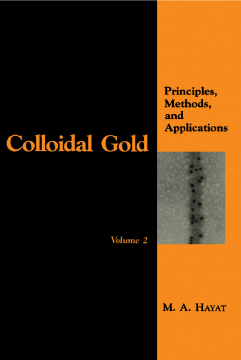
Additional Information
Book Details
Abstract
Since its introduction in 1971, the development and application of colloidal gold as a marker in electron microscopy has been phenomenal. Colloidal gold has become the method of choice in immunocytochemistry and many areas of cell biology. This universal method is applicable to most microscopical systems including optical microscopy; scanning, transmission, and high voltage electron microscopy; photoelectron, photon, fluorescent darkfield, and epipolarization microscopy. Colloidal gold allows high and low resolution studies, enzyme and nucleic acid labeling, study of dynamic cellular processes, and virus detection. This book is among the first available to cover the principles and methodology of colloidal gold in microscopy.
- Methods are described step by step, to enable researchers to learn these complex procedures solely by reference to these books
- Problems and limitations of techniques are discussed
- Guides users to avoid problems and choose the correct procedures for specific applications
- Contributors are eminent authorities in their fields
"The chapters in these volumes are a measure of a healthy field of research and its applications." --ELECTRON MICROSCOPY REVIEW
"If you need to localise something within a cell, the colloidal gold series can probably tell you how to go about it." --EUROPEAN JOURNAL OF PROTISTOL
"This treatise is timely and extremely helpful for the scientist interested in applying the colloidal gold methodology for a particular research problem... The present volumes elegantly cover broad research applications that reach beyond the traditional field of microscopy in cell biology and extend into the field of molecular biology... An attempt has been made to include a distinguished group of experts who are the originators of the techniques; many continue to play an active role in the technical development. The authors are from diverse fields, so that these books will be attractive to a wide audience including cell biologists, pathologists, virologists, and developmental and molecular biologists. The printing of the hardbound books is of prime quality, with excellent reproductions of the well-chosen micrographs... The text, printed on glossy paper, is extremely easy to read; diagrams, drawings, and tables throughout the two volumes are particularly pertinent in illustrating the principles and steps of many of the procedures. Although each chapter is written by a different author, all consistently follow a well organized pattern. The chapters begin with an introduction and historical background, then follow with preparation of probes and specimens, principles and descriptions of the methods for labeling, descriptions of the experimental results with a review of the literature, conclusions, and a list of citations to many original references. A particularly valuable part of each chapter is the assessment of the advantages, limitation, and pitfalls of a given methodology... These two volumes are a mix of reference book, student textbook, and cookbook. On the whole, the descriptions of methods are thorough and stimulating, and will be most useful to the experienced reader seeking to select the procedure most suited to a particular research problem. The in-depth account of the methodology and the extensive references provided will be of great help to those interested in assessing the potential and limitations of colloidal gold methodology. These books are a good blend of the old and the new, and are at their best when they provide a focused presentation of the recent direction in the field of the red colloid." --EMSA BULLETIN
